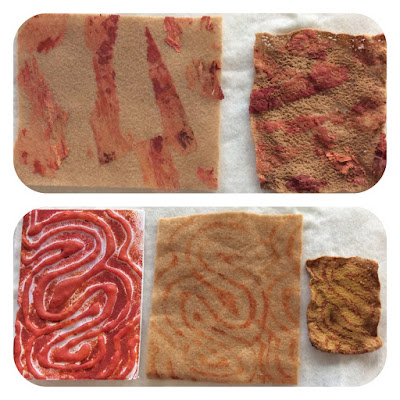We learned several things in our October session, especially
the items used to collage the printing plates themselves and how each behaved
when printing with acrylic or fabric paints or the Speedball™ printing ink.
Without a doubt, the simpler the collage, i.e. a single
layer of cereal box cardboard or a thin crocheted doily, the better the mono
print that resulted. As this was mostly a trial and error day, we used craft
acrylic paint and copy paper for our printing.
 |
| Thin doily. |
 |
| Thin cereal box cardboard. |
The second AH HA moment was that a more interesting print
resulted when there were larger areas of open space between the elements of the
collage. Not only did you get the printed image of the slightly raised area of
the plate. In some cases you also got an imprint of the background area.
 |
| Interesting background print. |
We found differences in techniques for the actual printing
depending on how you “inked” up your plate and how you printed it. If you inked you plate and had your copy paper on a piece of
craft foam, you could use your plate like a rubber stamp, placing it face down
onto the paper. This gave you the opportunity to evenly press on the plate to
get a good print.
If you inked your plate and had it face up on the table, you
could then place your fabric or paper face down onto the plate and use your
hands or a spoon to work the ink onto the receiving surface. This is the
technique that gave the best results of an imprint into the background areas of
the plate.
 |
| Adhesive craft foam on cardboard. |
 |
| The perfect print. |
We did not come
ready with the supplies for this last technique, but if you have access to an
actual printing press, perhaps a Sizzix Big Shot™ or a flower press, it is
apparently possible to use these devices to emboss damp paper using your
collograph plate. That’s a technique for a long winter’s day.
I personally liked the effect of printing using black
Speedball™ Fabric Printing ink. I suspect we should have used a medium of some
sort to make the ink slightly more fluid, but we brayered it onto a flat
surface, pressed the printing plate into the ink and printed to our new
surface.
It is best to do a couple of dud prints first and then do your final
print. Less ink gives a much better imprint. On some of the plates it seemed to
work better to apply the ink directly to the plate working it in with a cheap
bristle brush and then do your print.
Here are two techniques that are very easy to do. The latter is not actually a collograph plate but gives much the same effect.
 |
| Eggshell printing plate. |
 |
| Incised Styrofoam tray. |
This is certainly a technique that warrants some additional
exploration, especially if you wanted to make prints that were entirely of your
own design and making.










































